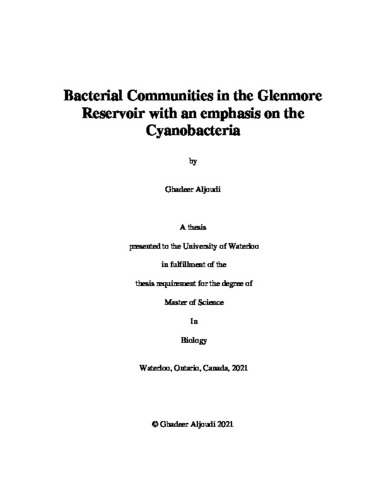| dc.description.abstract | Lakes and reservoirs play an essential role as a source for freshwater that can be potable after proper treatment, or for irrigation to meet the water needs of the population, industry, and agriculture. However, freshwaters bodies face significant challenges (including pollutant loads and climate change) that may lead to water quality degradation; among these are taste and odour events and harmful bacterial blooms. In Calgary, Alberta, Canada, runoff from agriculture and residential development in urbanized watersheds also contributes to water quality deterioration in the Elbow River, which flows into the Glenmore Reservoir and serves as one of the primary sources of drinking water for the city. While harmful algal blooms (i.e., Cyanobacteria) have not occurred in the Glenmore Reservoir historically, increased pressures (e.g., stormwater discharges, potential erosion and runoff after wildfire) on source water quality in the city’s wildfire-prone source watersheds have the potential to increase nutrient (especially bioavailable phosphorus) loading to the reservoir; this can promote algal blooms (City of Calgary, 2018). Therefore, to enable identification of source water quality shifts and treatment challenges that may impact the provision of adequate amounts of safe drinking water, it is important to monitor both water quality and bacterial and cyanobacterial communities within the reservoir. This research focused on identifying and detecting the bacterial and cyanobacterial communities that present in oligotrophic Glenmore Reservoir in Calgary, AB. The 16S rRNA gene next-generation sequencing (NGS) was applied to investigate bacterial and cyanobacterial composition in the reservoir and detect any problematic taxa that may lead to concerns regarding the quality of the drinking water. Major findings revealed that Actinobacteria, which are known to produce geosmin and 2-MIB (taste and odour compounds), were the second most dominant phylum and may be metabolically active residents due to their adaptation to nutrient-poor environments and thus potential sources of T&O (taste and odour). In addition, sequences from the cyanobacterial community matched two potential toxin-producing genera: Synechococcus sp. and Planktothrix agardhii. This preliminary analysis can provide baseline information against which subsequent, more detailed investigations of reservoir bacterial and cyanobacterial communities may be compared. | en |

